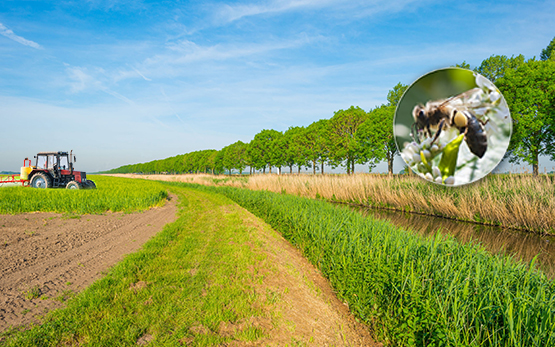Agroscope examined whether it is possible to forgo the use of PPPs with a high risk potential for the environment. The results show that this would make effective crop protection more difficult, especially for field and vegetable crops, but also in organic farming.

Various agricultural policy measures (PPP Action Plan, Parliamentary Initiative) aim to reduce the use of plant-protection products (PPPs) as well as the risks associated with them. The AP22+ is also meant to apply greater restrictions on the use of certain PPP active substances in the Proof of Ecological Performance (PEP) in future. The aim is to reduce groundwater pollution and the risks for surface waters and bees, whilst continuing to protect crops. In the present study, Agroscope has analysed the options and consequences of restricting the use of active substances with a high risk potential.
Risk posed by PPPs for surface waters and bees
The risk potentials of the active substances authorised at the beginning of the study (March 2019) were determined with risk scores (risk assessments using a simplified, standardised method) for groundwater, surface waters and bees. Risk-mitigation measures such as use restrictions were not included in the assessment.
Using the risk scores, active substances were ranked according to their risk potential:
- The 15 active substances with the highest potential for groundwater contamination by metabolites consisted of ten herbicides (weed control) and five fungicides (control of fungal diseases).
- Insecticides (control of harmful insects) and acaricides (mite control) had the highest risk scores for surface waters.
- For bees, it was also mainly insecticides and acaricides that were identified as potentially high-risk.
Protecting crops with fewer risks for the environment
Agroscope examined the extent to which active substances with a higher risk score could be replaced by active substances with a lower risk score. For this purpose, an agronomic evaluation of approved active substances with full or partial efficacy was carried out, taking account of existing or anticipated resistance problems. For twelve insecticides/acaricides, eleven herbicides, five fungicides and one phytoregulator (i.e. plant-growth regulator), the researchers analysed how crop protection might be affected if PPP use were subject to restrictions.
PPP use in arable and vegetable crops difficult to replace
Restricting the use of insecticides with the highest risk potentials would make effective plant protection impossible for certain arable and vegetable crops. Particularly in vegetable crops, restricting the use of the herbicides and fungicides examined would also have negative effects.
By contrast, in fruit and berry production and viticulture, there are in most cases several effective alternatives available to the examined insecticides.
Spinosad important in organic farming
When forgoing the use of Spinosad, an insecticide also approved for organic farming, greater difficulties in integrated and organic production in all examined application domains must be expected.
Conclusions
- Agroscope’s study provides a decision-making basis for determining restrictions of the available active substances in PEP.
- The active substances with the highest risk potentials were identified based on a standardised risk score.
- A broad restriction of the high-risk-potential active substances would have far-reaching consequences, particularly for the protection of arable and vegetable crops.
- Restricting the use of Spinosad could in some cases lead to major problems in organic crop production.
- Active further development of plant-protection strategies that make do with reduced PPP use is essential in order to mitigate the consequences of restrictions on active substances.
Further Information
Last modification 29.09.2020





